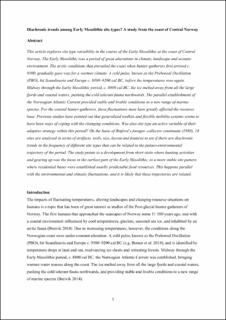| dc.description.abstract | This chapter explores site-type variability in the course of the Early Mesolithic at the coast of central Norway. The Early Mesolithic was a period of great alterations in climate, landscape and oceanic environment. The Arctic conditions that prevailed on the coast when hunter-gatherers first arrived c. 9500, gradually gave way to a warmer climate. A cold pulse, known as the Preboreal oscillation (PBO), hit Scandinavia and Europe c. 9300–9200 cal bc, before the temperatures rose again. Midway through the Early Mesolithic period, c. 8800 cal bc, the ice melted away from all the large fjords and coastal waters, pushing the cold-tolerant fauna northwards. The parallel establishment of the Norwegian Atlantic Current provided stable and liveable conditions to a new range of marine species. For the coastal hunter-gatherers, these fluctuations must have greatly affected the resource base. Previous studies have pointed out that generalized toolkits and flexible mobility systems seem to have been ways of coping with the changing conditions. Was also site type an active variable of their adaptive strategy within this period? On the basis of Binford’s forager–collector continuum (1980), 18 sites are analyzed in terms of artefacts, tools, size, layout and features to see if there are diachronic trends in the frequency of different site types that can be related to the palaeoenvironmental trajectory of the period. The study points to a development from short visits when hunting activities and gearing up were the focus in the earliest part of the Early Mesolithic, to a more stable site pattern where residential bases were established near predictable food resources. This happens parallel with the environmental and climatic fluctuations, and it is likely that these trajectories are related. | en_US |
